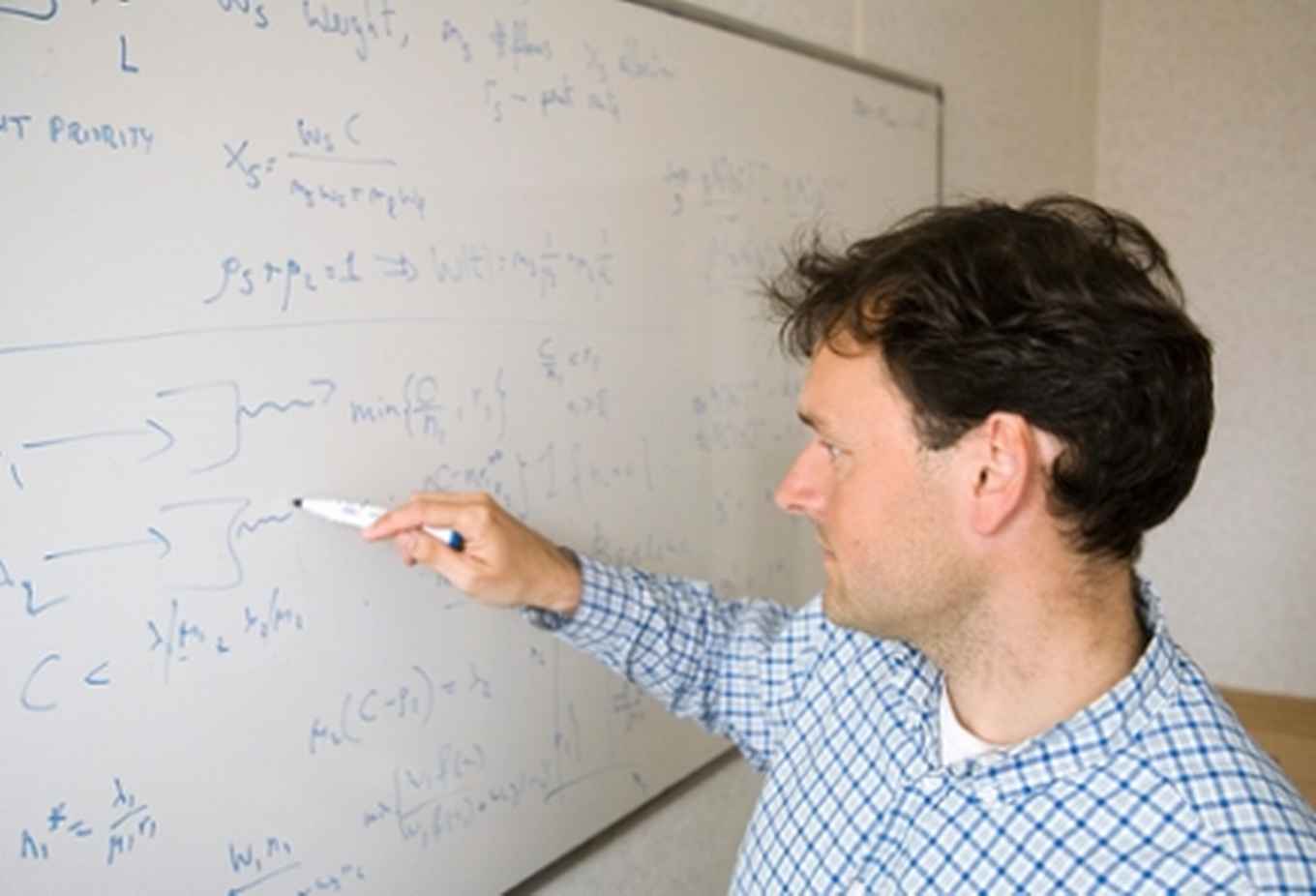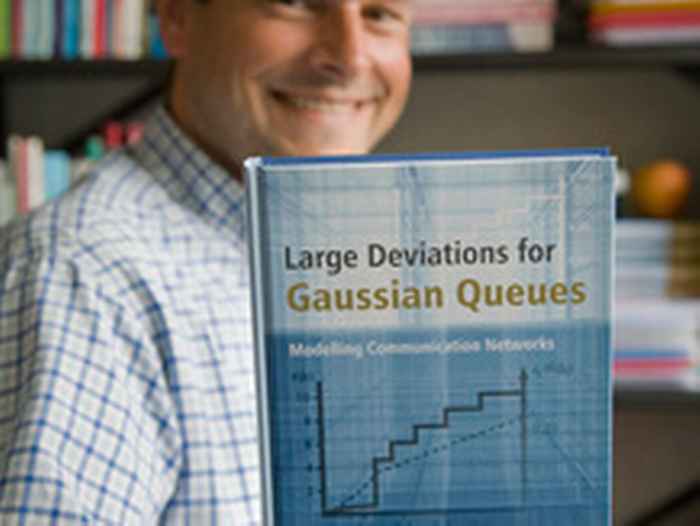Focus on research: operational research expert Michel Mandjes
A computer network, a clogged motorway or a warehouse awaiting new stock, operational research expert Michel Mandjes doesn't see the difference: all three are queues and at the Korteweg-de Vries Institute for mathematics Mandjes investigates how they might flow most efficiently. No more queues at the checkout?
Mandjes studied mathematics and econometrics at the VU and eventually chose an in-between field: operational research, a subject that uses mathematical techniques from statistics and probability calculus to optimalize processes. After his PhD he ended up in the business world, working for two years at KPN where they were setting up the first high-speed network in the Netherlands at the time. Mandjes concentrated on issues such as where to situate junctions, how large they should be and whether there was a demand for varying speeds. ‘In KPN terms my work was fundamental, while to me it was rather practical work', says Mandjes. Although he enjoyed working there, in the long term he missed the more in-depth, scientific contact with colleagues. ‘For KPN, finding a reasonable solution was sufficient whereas I was of the opinion that more lengthy research would produce a better solution.'
And so Mandjes returned to fundamental research at Bell Laboratories in the USA. ‘We did pure mathematics under the alibi of network optimalization. I had a fantastic time there.' This type of research suited him so well that he decided to continue it in the Netherlands, initially as part-time professor at Twente and the Centre of Mathematics and Informatics at Amsterdam, and now as fulltime professor at the UvA.

Contract research
Besides supervising PhD students and teaching, Mandjes works intensively on contract research. "We get assignments from trade and industry and participate in projects. In the business community, people are often just looking for a number rather than being interested in the underlying calculations. For example, we were recently asked "we have constructed a hard disk with a spare part: what is the chance that both the original as well as the spare part break down?" We are able to calculate an answer for them.'
The projects Mandjes carries out in collaboration with industry and scientific institutes are financed, for example, by the EU or by the Ministry of Economic Affairs. This type of project is often on a larger scale and also of a more scientific nature than projects which originate directly from trade and industry. "For one project, we recently looked at network design, not only the design of a single part such as e.g. the connection network or perhaps the backbone, but the integral design. The client's user experience plays an important role here: how slow may the network be while still remaining acceptable to the user? It turned out, for example, that a delay of a maximum of 100 milliseconds would be tolerable for conducting conversations on the Internet. That's the type of figure I'm looking for, as I can then calculate under which circumstances these conditions can be achieved. Eventually you are able to get an end-to-end view, the picture is complete. That had never been done before for network design.

‘If you let your research be steered solely by the business world, you would end up with rather boring problems,' he laughs. ‘In the end, you want to carry out research that really interests you. Right now, for example, I'm investigating the correlation structure of reflected Lévy processes, which relate to all sorts of queue systems - think, for example, of a factory which processes packages.' Mandjes walks up to the board and draws a line of various types of packages. ‘A stream of packages goes through the factory, sometimes many at the same time, then none at all, then again a few small packages, and then a rather large one. If a stream of packages keeps flowing in, one after the other, for a longer period of time, they cannot be processed at once and you get a larger buffer content.'
The size of the buffer content depends on what is put into it. A Lévy process awards a certain regularity to the input at the factory, to the amount, size and sequence of the packages. A Lévy process is an input process with independent increments, i.e. if you take two intervals that have no overlap, they are independent of each other: which packages go into the factory and how they do so is independent of the packages that went through before. ‘Lévy processes are often used in all sorts of financial applications. For example, it turns out that you can model stock market prices rather well with this type of process.'
'I am interested in the correlation between the buffer content at the moment that the factory opens at a certain point of time - zero - and the buffer content at a later point of time. The more time between these points, the weaker the correlation between the two buffer contents. After a hundred years, the influence of one particular buffer content on one particular morning will, of course, be negligible. However, how quickly does the correlation go to zero?' Mandjes formulates this queue problem in an abstract manner and hopes that it will subsequently be applied to a variety of practical problems.
Rubik’s cube
Mathematics has the reputation of being difficult and perhaps even boring. ‘I think that lots of people have that opinion because they found mathematics difficult at secondary school. Challenging this viewpoint sometimes seems hopeless, despite the fact that people love puzzles - look at the Sudoko craze, for example! When I was younger, I used to play around with Rubik's cube. This is all mental training, you learn how to calculate faster and how to think in abstract terms. Mathematics is often just a puzzle, and I think that lots of people could like mathematics.'
‘People who like mathematics do so either because they think it is useful, helping them to come to grips with the world about them, or because mathematics has depth and reveals structures. You see how things work - and they often work much more smartly and simply than you assumed to start off with. Mathematics is, in fact, a quest for beauty. I myself find mathematics so fantastic that I am willing to work hard for it. In my opinion, you'll often achieve more - and with greater pleasure - if you pursue a subject that fascinates you. I am inclined to think that when people chose something, they should do so with their heart and soul.'
‘However, I don't use my knowledge of mathematics in the supermarket - just like everyone else, I also always choose the wrong line,' laughs Mandjes. ‘However, it is probably the reason I never visit the casino - I know you can never really win.'
Boys’ Book Sensation
There's a neat row of notebooks in Mandje's bookcase, in which he is working on various problems - about fifteen at present. ‘That may seem a lot, but of course I don't work on them all at the same time: they're all in different phases of development - one is nearly finished, and I know there's a nice idea in another that I need to follow up. I make lists in order to keep track.'
Mandjes can often be found in his study or in a meeting room, deep in discussion with colleagues or students in front of a whiteboard full of notes. However, his workplace is not the only environment in which good ideas pop up. ‘I had a flash of inspiration on the sofa at home yesterday as to how I could approach a particular problem. That's what makes it all so exciting, that boys' book sensation I sometimes get when I'm doing research. You're working at the boundaries of what is and isn't known. I'm working on this particular problem together with a PhD student, and he has solved another part of the story. We're going to write a paper on this subject together.'
The mathematician shows us his most recent notebook, full of formulas and theorems. ‘Look, I started out on the problem here, thinking that I would be able to take an elementary approach, but that didn't work at all!' He thumbs through a few pages. ‘It was only here that, with the help of Google, I discovered that there is a paper which describes how, for a particular case of my model, the problem was solved in a totally different manner using Bernstein's theorem from 1928. The question then was whether I would be able to make the same steps described in the paper in my own, more general model. Things seemed to go wrong at first but now, thanks to the nice properties of Lévy processes, it seems as if it might be possible', says Mandjes enthusiastically. ‘Furthermore, the solution for that particular case of my model was solved in a rather ungainly manner in the paper. I expect that my solution for the more general model will ultimately turn out to be much shorter and more elegant. Again, that search for beauty!', he laughs. Will this be the next problem on his list to be solved? ‘I can't wait to continue working on it.'
21 August 2012